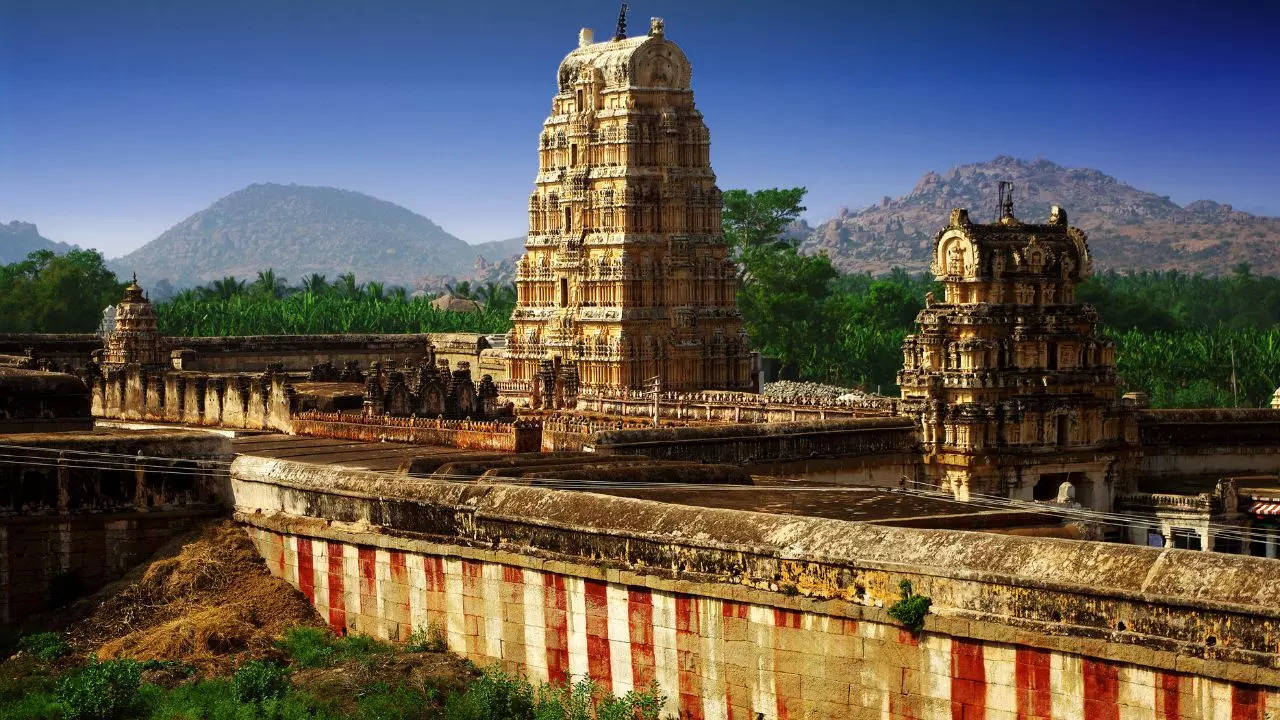Table of Contents

In the 14th century, the last great Hindu kingdom of India, the Vijayanagara Empire, made Pampa, the modern-day Hampi, its capital. Historical records reveal that the city, with its seven layers of fort walls, was one of the largest in the world. Today, this UNESCO World Heritage Site has ruins of ancient temples, palaces, and market streets, set against rugged hills and rocky terrain. With winter bringing cooler temperatures, now is the perfect time to book your trip to this incredible city.
Day 1: Tracing Hampi’s Rich Heritage
Morning: Sunrise at Matanga Hill
Start your Hampi adventure by witnessing a stunning sunrise from Matanga Hill. Known for panoramic views of the ruins and the river, Matanga Hill is the highest point in Hampi and has many small nooks that can be explored early in the morning. Beware of monkeys, who are notorious for stealing food from the hands of travellers. Matanga requires a bit of a climb, but the rewarding views over the city’s historic landscape make it well worth the effort.
Mid-Morning: Virupaksha Temple
From the Matanga Hill, you can make your way down to the Virupaksha Temple, which is dedicated to Lord Shiva and is one of Hampi’s most iconic landmarks. The intricately carved temple, believed to date back to the 7th century, has a towering gopuram (gateway) that’s hard to miss. Take your time exploring the impressive architecture and watching the temple elephant, Lakshmi, who blesses visitors with her gentle touch.
Evening: Hampi Bazaar and the Royal Enclosure
You can either start by exploring the bazaar area located on the periphery of the Virupaksha temple, Take a walk through Hampi Bazaar, a bustling marketplace during the Vijayanagara Empire. Today, it’s a scenic street lined with ruins, handicraft shops, and eateries. From here, head to the Royal Enclosure. The former royal palace grounds boast must-see sites like the Elephant Stables and Lotus Mahal, both well-preserved with unique architecture blending Hindu and Islamic styles, including domes, arches, and intricately carved walls and pillars.
Another notable site is the Hazara Rama Temple, whose walls are like an open book, with carvings depicting elephants marching, women dancing, warriors in combat, and horses preparing for battle—stories etched in stone. You actually need a whole day for the royal enclosure but if you’re short on time, make sure to visit the Lotus Mahal and this temple.
Day 2: Exploring Hampi’s Natural Beauty
Morning: Vittala Temple and the Stone Chariot
Start your walk on the outskirts of the complex, and explore ruins of many smaller temples before making your way to the Vittala Temple, which is about 2 kilometres away. Known for the Stone Chariot, which has become a symbol of Karnataka’s heritage (and features on Indian currency as well), this temple is an architectural marvel. Don’t miss the musical pillars, which resonate with sounds when tapped. We highly recommend hiring a guide to learn about the temple’s intricate details and historical significance. The local guides are also incredible with pictures inside this temple.
Late Morning: Coracle Ride and Anegundi Village
It is obvious that you can’t leave this city without a coracle ride on the Tungabhadra River. These traditional round boats offer a unique experience and stunning views of the landscape. Cross over to Anegundi Village on the northern side of the river to explore lesser-known sites like the Hanuman Temple on Anjaneya Hill. Said to be the birthplace of Hanuman, this spot requires a bit of a climb (takes about 40 odd minutes) but rewards you with amazing views over Hampi.
Afternoon: Sacred Center and Achyutaraya Temple
Come back to the Sacred Center, and make your way to ancient sites like the Achyutaraya Temple (which will remind you of the Angkor Wat Temples, if you’ve been there) and Kadalekalu Ganesha. This part of Hampi is less crowded and allows you to experience the sacred spaces in a quiet, contemplative manner. The Achyutaraya Temple is especially stunning, with dilapidated walls and elaborate carvings of ancient times.
Evening: Hemakuta Hill Sunset
End the day with a serene sunset at Hemakuta Hill, which has a scattering of ancient temples and offers panoramic views of Virupaksha Temple and the surrounding landscape. The sunset here is a photographer’s delight, with Hampi’s ruins bathed in golden hues.
Also Read: We Spent A Monsoon Weekend At Hampi’s Most Beautiful Hotel; Here’s Why You Should Too

